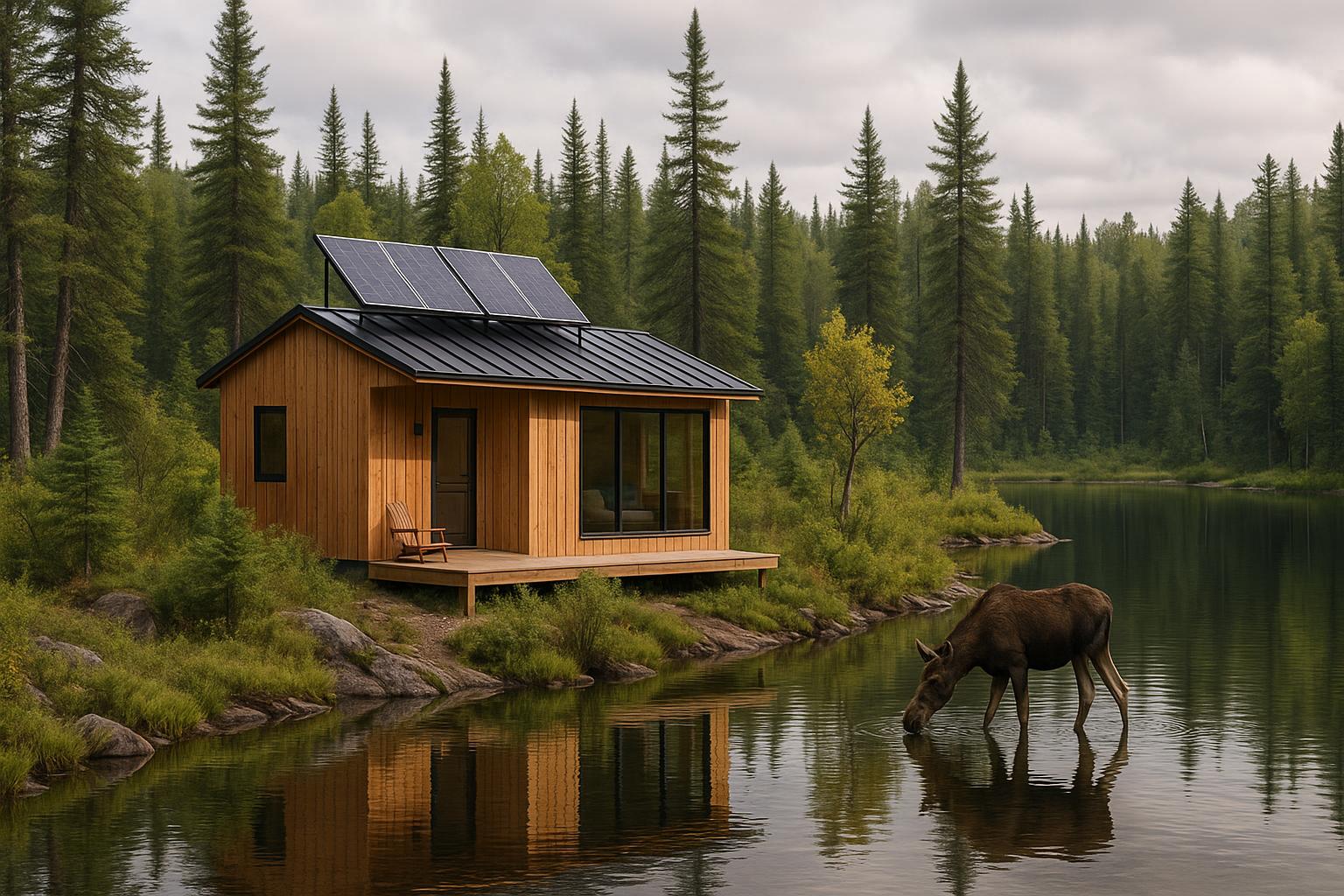
Designing Your Off-Grid ADU: A Sustainable Wildlife Retreat in Canadian Nature
Estimated reading time: 10 minutes
Key Takeaways
- Energy Independence – Off-grid ADUs are designed to operate without municipal utilities.
- Sustainable Materials & Eco-Building – Emphasizing renewable energy systems, reclaimed timber, and low-impact construction methods.
- Wildlife & Nature Integration – Thoughtful site selection and design minimize ecological disturbance and support local fauna.
- Modern Comforts – Balancing contemporary amenities with nature-inspired, eco-friendly living.
- Resilient Living – Ensuring reliable power and water independence for even the most remote Canadian retreats.
Table of contents
- Introduction: The Off-Grid ADU in Canadian Nature
- Understanding Off-Grid ADUs: Wildlife Retreat Benefits
- Site Selection for Your Off-Grid ADU: Integrating with Canadian Nature
- Sustainable Design Principles: Eco-Building for Wildlife Retreats
- Practical Considerations for Building an Off-Grid ADU: Eco-Building Essentials
- Creature Comforts and Wilderness Respect: Harmonizing a Wildlife Retreat
- Real-World Inspiration: Off-Grid ADU Wildlife Retreats in Canada
- Conclusion: Embracing Off-Grid ADUs for Sustainable Wildlife Retreats
- Frequently Asked Questions
Introduction: The Off-Grid ADU in Canadian Nature
An off-grid ADU is a compact, self-sufficient residence designed to function independently of municipal utilities, making it perfect for remote locations and nature lovers. As tiny homes and wildlife retreats become more popular across the Canadian wilderness, many are seeking ways to combine modern creature comforts with sustainable design.
By using eco-friendly building methods, respecting native landscapes, and prioritizing environmental stewardship, you can create a wildlife retreat that feels both luxurious and true to nature. Simply put, an off-grid ADU is built to operate without the need for city water, sewer, or electrical systems. For more details on its definition, please visit this resource.
Understanding Off-Grid ADUs: Wildlife Retreat Benefits
An off-grid ADU serves as a secondary dwelling that harnesses renewable energy sources—like solar panels, wind turbines, or micro-hydro systems—and comes complete with independent water and waste management systems. Unlike conventional ADUs, it guarantees complete energy independence.
Key Advantages of an Off-Grid ADU Wildlife Retreat
- Absolute privacy: Perfect for secluded backcountry lots or forested terrains.
- Smaller carbon footprint: Renewable energy and eco-building practices substantially reduce emissions.
- Reliable during outages: Keeps your retreat operational even when municipal grids fail.
- Wildlife protection: Eco-conscious building lowers human impact, allowing local species to flourish.
For more in-depth strategies on compact living that maximize small spaces in an eco-conscious manner, check out Tiny Home Living: The Ultimate Guide to Affordable, Sustainable, and Stylish Compact Living.
Site Selection for Your Off-Grid ADU: Integrating with Canadian Nature
Choosing the right location for your off-grid ADU is just as critical as the design itself. The location must balance privacy, accessibility, and the ability to coexist in harmony with the surrounding natural environment.
Tips for Choosing an Off-Grid ADU Wildlife Retreat Site
- Evaluate natural terrain and water sources:
- Identify sites near lakes, rivers, or sustainable groundwater sources.
- Ensure proper evaluation of soil, drainage, sunlight, and wind exposure.
- Respect critical wildlife corridors and habitats:
- Position the ADU away from migratory paths or sensitive ecological zones.
- Utilize wildlife mapping tools or consult local biologists.
- Select previously disturbed areas:
- Opt for natural clearings or land that has already been impacted.
- Minimize further clearing to protect mature forests and sensitive species.
- Plan for accessibility:
- Ensure there are adequate access routes for material delivery and maintenance.
Thoughtful site research is key to creating a wildlife retreat that respects Canadian nature. Learn more about these practices at this reference or explore Backyard Cottage: The Practical Canadian Guide to Design, Value, Zoning, DIY Building, and More.
Sustainable Design Principles: Eco-Building for Wildlife Retreats
Sustainable design is the cornerstone of any off-grid ADU. The aim is to construct a home with minimal environmental impact while ensuring comfort and functionality, particularly crucial for a wildlife retreat set in Canadian nature.
Eco-Building Materials and Methods
- Eco-friendly construction materials:
- Prioritize sustainably sourced wood for framing and cladding.
- Utilize recycled or low-carbon products like reclaimed timber and low-VOC finishes.
- Source materials locally to reduce transportation emissions. See more at this resource.
- High-performance envelopes:
- Incorporate super-insulated walls, roofs, and triple-glazed windows to combat Canada’s extreme weather.
- Maintain airtight construction to reduce energy loss.
- Energy efficiency features:
- Maximize natural lighting with well-placed windows and skylights.
- Design for passive solar gain in winter and natural shade in summer.
- Water conservation strategies:
- Implement rainwater harvesting systems paired with low-flow fixtures and greywater recycling.
- Blend with the landscape:
- Utilize green roofs, natural color palettes, and indigenous landscaping to harmonize the retreat with its surroundings.
These techniques not only minimize environmental impact but also create a cohesive sanctuary in the Canadian wilderness. For more insights, visit Eco-Friendly Building Materials: Innovations and Best Practices for Tiny Homes and ADU Construction in Canada 2025.
Practical Considerations for Building an Off-Grid ADU: Eco-Building Essentials
Constructing an off-grid ADU requires meticulous planning and the integration of various systems to ensure self-sufficiency.
Construction Methods for Off-Grid ADUs
- Prefabricated kits and modular builds:
- Manufactured offsite with faster build times and reduced waste.
- Engineered for energy efficiency and off-grid operation.
- Traditional craftsmanship:
- Engage local builders and use regionally sourced timber for a custom touch.
- Strengthen community connections and minimize transportation emissions.
Infrastructure for Self-Sufficiency
- Renewable energy systems:
- Reliable off-grid solar panels with battery backup serve as the heart of energy independence.
- Supplement with wind or micro-hydro systems as needed.
- Water collection and filtration:
- Use rainwater catchment systems paired with gravity-fed or solar-powered filters.
- Waste management solutions:
- Incorporate composting or incinerating toilets to minimize environmental impact.
- Modern heating options:
- High-efficiency wood stoves, propane heaters, or heat pumps combined with super-insulation reduce energy needs.
These systems come together to deliver an off-grid ADU that is both sustainable and resilient. Explore further details at Prefab House Revolution: How Modular Design is Redefining Modern Housing with Cost Savings, Fast Construction, and Sustainability.
Creature Comforts and Wilderness Respect: Harmonizing a Wildlife Retreat
Establishing a wildlife retreat in the Canadian wilderness means blending modern comforts with nature-sensitive design.
Low-Impact Living in Off-Grid ADUs
- Quiet, energy-efficient technology:
- Select appliances that minimize both energy consumption and noise.
- Minimal light pollution:
- Install downward-shielded, motion-activated outdoor lights and internal blackout treatments to ensure nocturnal wildlife remain undisturbed.
- Ethical landscaping:
- Favor native plants and natural lawns over chemically treated gardens to maintain local biodiversity.
- Noise and traffic reduction:
- Design driveways and footpaths to channel movement away from sensitive areas.
- Responsible stewardship:
- Establish clear guidelines for guests, ensuring no feeding of wildlife and adherence to leave-no-trace principles.
This balanced approach permits a truly immersive experience in nature while preserving the local ecosystem. For creative outdoor ideas, visit Landscaping Ideas for ADUs: Creative and Practical Strategies to Boost Curb Appeal in Canadian Gardens.
Real-World Inspiration: Off-Grid ADU Wildlife Retreats in Canada
British Columbia: Modular Off-Grid Forest Retreat
A pioneering project in BC utilized modular ADUs to craft secluded retreats deep within old-growth forests. These units feature locally harvested timber, recycled steel, full solar arrays with lithium battery banks, rainwater catchment with advanced filtration, and eco-conscious design elements such as green roofs and earth-tone siding.
Ontario: Energy-Efficient Remote ADUs
In Ontario, adaptable ADU designs are being modified for complete off-grid operation. Examples include super-insulated, triple-glazed constructs manufactured using prefab techniques that reduce site disturbance, paired with renewable energy sources and water recycling systems.
These projects set benchmarks for sustainable building and wildlife retreat practices. Further inspiration can be found at Modular Homes: Cost-Efficient, Sustainable, and Quick-Build Housing Solutions for Canada.
Conclusion: Embracing Off-Grid ADUs for Sustainable Wildlife Retreats
A well-conceived off-grid ADU opens the door to experiencing Canada’s wild landscapes in an eco-friendly, self-sufficient manner. By integrating renewable energy, sustainable building practices, and a deep respect for nature, these retreats offer:
- Full energy independence and resilience against outages.
- Unparalleled privacy in secluded natural settings.
- Minimal ecological impact, ensuring the preservation of local wildlife and habitats.
- A harmonious blend of modern comfort and nature’s tranquility.
Before embarking on your project, be sure to research local ADU regulations and best practices to protect and enrich Canada’s natural heritage. Learn more at this source and this resource. Embrace the movement towards a lifestyle that balances modern living with environmental stewardship, right in the heart of Canadian nature.
For further reading on self-sufficient living, explore Off-Grid Living in Canadian Tiny Homes: Essential Systems and Solutions for a Sustainable, Self-Sufficient Lifestyle.
Frequently Asked Questions
What is an off-grid ADU?
An off-grid ADU is a secondary dwelling constructed to operate independently of city utilities. It relies on renewable energy sources, independent water systems, and eco-friendly building methods to promote self-sufficiency and environmental harmony.
How does an off-grid design benefit a wildlife retreat?
By eliminating reliance on municipal utilities and employing sustainable materials and energy systems, off-grid ADUs reduce their ecological footprint. This not only protects local wildlife and habitats but also provides a private, uninterrupted connection with nature.
Are there modern comforts in an off-grid ADU?
Yes, off-grid ADUs are designed to offer modern amenities—such as efficient lighting, heating options, and comfortable living spaces—while still prioritizing energy efficiency and low environmental impact.

Leave a Reply